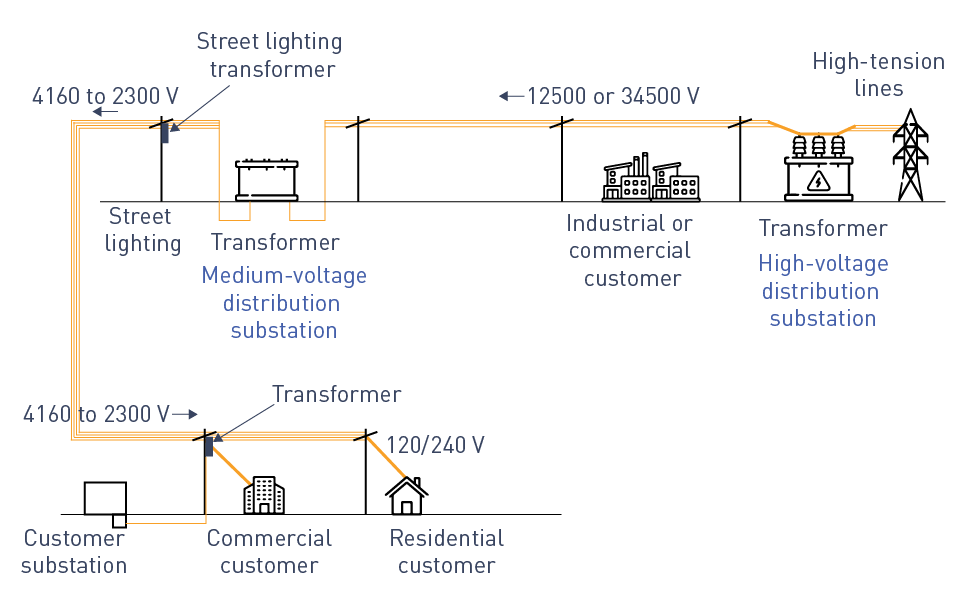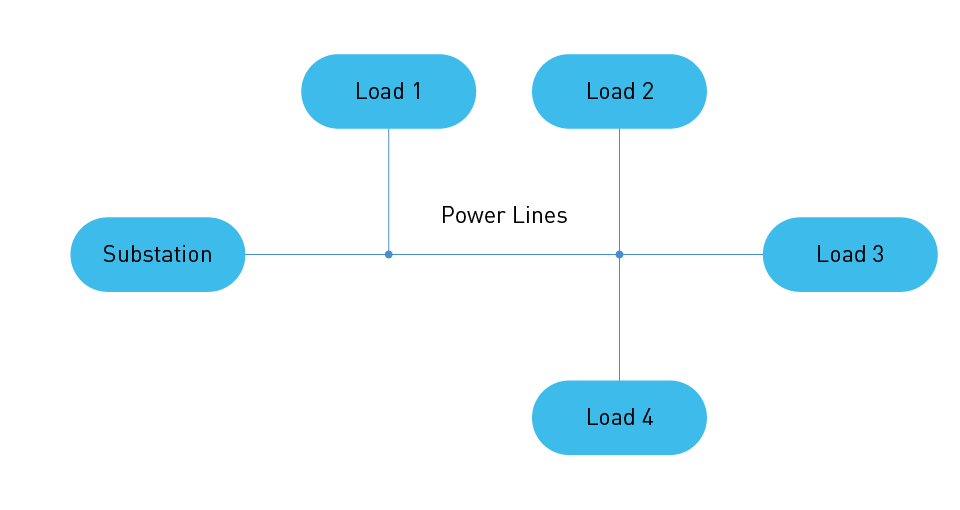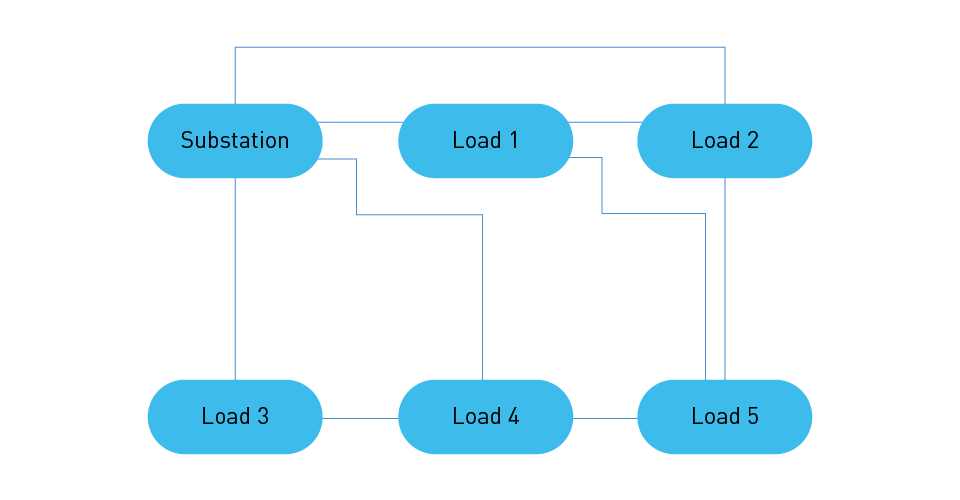AC Power Distribution System Components
The distribution of electrical power is the final and most important step in the journey of electricity from generating facilities to consumers. AC power distribution systems are designed to provide electricity to users in the residential, commercial, and industrial sectors in a safe, efficient, and reliable manner. This section delves into the major components of AC power distribution systems, including distribution lines, distribution transformers, circuit breakers and switchgear, distribution substations, and voltage regulators.

Figure 18: Power distribution architecture
Distribution Lines
Distribution lines are pipes that transport electricity from distribution substations to users. They operate at lower voltages than transmission lines and span cities, communities, and rural regions, establishing a complex network that assures power to every end user. Distribution lines can be installed above, on poles, or underground, to protect against weather damage and improve aesthetics in metropolitan areas. There are financial, maintenance, and reliability trade-offs when deciding between overhead and subterranean lines.
Distribution Transformers
Distribution transformers serve an important function in regulating voltage to safe levels for end-use applications. These transformers, which are installed on poles, in underground vaults, or on pads in residential and commercial areas, step down the voltage received from distribution lines to the levels required by various types of consumers, typically ranging from 120/240V for residential use to higher voltages for industrial facilities. Efficient transformer operation is critical for reducing energy losses and providing the quality of power supply.
Circuit Breakers and Switchgear
Circuit breakers and switchgear are key components in the protection and control of distribution systems. Circuit breakers automatically stop the flow of electricity in the case of an overload or a short circuit, protecting the network and assuring safety. Switchgear includes a wide range of devices such as circuit breakers, switches, and control equipment that allow operators to regulate power distribution, isolate network parts for repair, and restore service after a problem.
Distribution Substations
Distribution substations are nodal points in the distribution network that receive high-voltage power from transmission lines before stepping it down for distribution. These substations hold transformers, switchgear, and control equipment and serve as important hubs for voltage transformation and distribution system management. They allow for the efficient and flexible routing of electricity within the distribution network, adjusting to changing demand patterns and guaranteeing reliability.
Voltage Regulators
Voltage regulators keeps voltage levels within an acceptable range, adjusting for variations caused by changes in load or other variables impacting the distribution network. Voltage regulators maintain constant power quality for users by automatically changing transformer taps or applying electronic control circuits, protecting sensitive equipment and enhancing electrical appliance performance.
Process of Distributing Power to End-Users
The distribution of electrical power to end users is the final and critical step in the journey of electricity from generation to consumption. This process consists of a number of carefully constructed steps and components, each of which plays an important part in ensuring that electricity is provided effectively, safely, and reliably to customers, whether they be residential households, commercial enterprises, or industrial facilities. This section describes the process of delivering power to end consumers using AC power distribution systems.
Step 1: Receiving High-Voltage Power
The process begins at distribution substations, where high-voltage electricity transmitted over large distances from power plants. These substations are carefully situated near demand centers to provide optimal electricity distribution over many locations.
Step 2: Voltage Transformation
Within the distribution substations, high-voltage power is converted to lower voltages ideal for distribution. Distribution transformers at these substations reduce voltage to levels that may be safely transferred to end users via the distribution network. This voltage decrease is critical for reducing transmission losses and guaranteeing the safety of the distribution process.
Step 3: Distribution via Lines
Once the voltage is reduced, the electricity is transported through distribution lines that connect the substations to the end consumers These lines can be either overhead (supported by poles) or subterranean (buried beneath the surface). Cost, aesthetic concerns, environmental effect, and dependability all play a role in determining whether overhead or subterranean lines should be used.
Step 4: Further Voltage Adjustment
As electricity moves through the distribution network, it may require further voltage alterations before reaching the end user. Pole-mounted or pad-mounted distribution transformers execute further step-down transformations, lowering the voltage to the levels necessary for residential, commercial, or industrial applications. This phase guarantees that power is provided at the correct voltage for the various sorts of applications and equipment.
Step 5: Final Delivery to End-Users
The last stage of the distribution process is the transmission of electricity from local transformers to individual end-users. This is accomplished by service drops for overhead lines and service laterals for subterranean lines, which connect the distribution network to the end user's location. Electricity enters the building via a service panel or meter, which records usage for billing purposes, before being supplied inside to various loads and outlets.
Maintaining Power Quality and Reliability in Distribution Networks
A power distribution system's ultimate purpose is to supply electricity to end consumers while maintaining a high level of reliability and quality. Power reliability and quality are critical in ensuring that electrical equipment runs effectively, safely, and uninterrupted. This section addresses the tactics and technology used in distribution networks to preserve power quality and reliability of the electric supply.
Power Quality Considerations
Power quality issues in distribution networks can be caused by voltage sags or swells, harmonics, flickers, and imbalances. These issues can cause equipment to malfunction, lower efficiency, and, in extreme circumstances, premature breakdown of electrical components. To ensure excellent power quality, distribution networks incorporate several measures:
Voltage Regulation: Voltage regulators are critical in keeping the voltage within the specified limits, correcting for voltage loss over lengthy distribution lines and fluctuating loads. Regulators aid in preventing issues caused by under- or over-voltage conditions by maintaining steady voltage levels.
Harmonic Filtering: Harmonic filters, both passive and active, help to reduce harmonic distortions generated by non-linear loads. Filters increase power quality by ensuring that the electrical supply's waveform is as near to a pure sine wave as possible.
Power Factor Correction: Power factor correction devices, such as capacitors and synchronous condensers, have been installed to decrease the voltage-current phase difference. This adjustment helps to reduce reactive power flow, which improves efficiency and reduces transmission losses.
Ensuring Reliability
Reliability in distribution networks is about reducing downtime and swiftly restoring electricity following outages. Multiple strategies and technologies are crucial for obtaining high reliability:
Redundancy and Network Configuration: Designing distribution networks with redundancy and loop or mesh configuration guarantees that there are alternate routes for the electricity in the event of a line or equipment failure. This design idea improves reliability by allowing for fast separation and rerouting of power around failed sections.

Figure 19: Radial power transmission

Figure 20: Ring power transmission

Figure 21: Network power transmission
Fault Detection and Isolation: Advanced monitoring and control systems, including smart sensors and automated switchgear, provide real-time detection and isolation. These systems can instantly determine the location and type of failure, isolate the afflicted section, and redirect power to reduce the impact on end-users.
Preventive Maintenance and Asset Management: Regular maintenance and prompt replacement of aged infrastructure lowers the chance of failure. Modern asset management systems combine data analytics and predictive modeling to improve maintenance schedules and asset replacement, assuring the network's durability and dependability.
Integration of Distributed Energy Resources (DERs): The use of DERs, such as rooftop solar panels and local battery storage, can improve reliability by diversifying power sources and lowering load on central distribution lines. Furthermore, microgrids may run independently from the main grid in the event of an outage, ensuring continuous power for essential loads.

Figure 22: Distributed energy resources
Operation of Power Distribution Systems
Power distribution networks operate by controlling the flow of electricity from substations to end users, ensuring that demand is satisfied without exceeding the network's capacity. Distribution system operators monitor load patterns, handle flaws, and dispatch maintenance personnel to address issues such as outages or equipment failures. Advanced Distribution management Systems (ADMS) and smart grid technologies are rapidly being utilized to improve the efficiency and reliability of distribution networks, allowing for real-time monitoring, automatic fault identification, and dynamic load control.
Challenges in Power Distribution
Distribution systems encounter a variety of issues, including:
Load Balancing: Ensuring electricity is delivered equally and efficiently, especially during peak demand periods, demands careful planning and supervision.
Aging Infrastructure: Many distribution networks rely on outdated components that may not be suitable for modern load demands or the incorporation of distributed energy resources like rooftop solar panels.
Reliability and Quality: Maintaining high levels of reliability and power quality, such as voltage stability and frequency control, is critical for customer satisfaction and the functioning of sensitive electronic equipment.
Safety and Security: Protecting the distribution network against physical damage, cyber-attacks, and catastrophic events is crucial to providing uninterrupted power delivery to essential services and the general public.


直接登录
创建新帐号